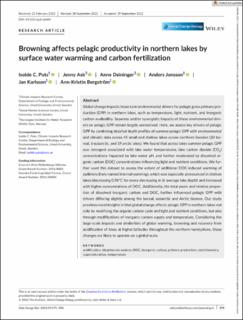| dc.description.abstract | Global change impacts important environmental drivers for pelagic gross primary production (GPP) in northern lakes, such as temperature, light, nutrient, and inorganic carbon availability. Separate and/or synergistic impacts of these environmental drivers on pelagic GPP remain largely unresolved. Here, we assess key drivers of pelagic GPP by combining detailed depth profiles of summer pelagic GPP with environmental and climatic data across 45 small and shallow lakes across northern Sweden (20 boreal, 6 subarctic, and 19 arctic lakes). We found that across lakes summer pelagic GPP was strongest associated with lake water temperatures, lake carbon dioxide (CO2) concentrations impacted by lake water pH, and further moderated by dissolved organic carbon (DOC) concentrations influencing light and nutrient conditions. We further used this dataset to assess the extent of additional DOC-induced warming of epilimnia (here named internal warming), which was especially pronounced in shallow lakes (decreasing 0.96°C for every decreasing m in average lake depth) and increased with higher concentrations of DOC. Additionally, the total pools and relative proportion of dissolved inorganic carbon and DOC, further influenced pelagic GPP with drivers differing slightly among the boreal, subarctic and Arctic biomes. Our study provides novel insights in that global change affects pelagic GPP in northern lakes not only by modifying the organic carbon cycle and light and nutrient conditions, but also through modifications of inorganic carbon supply and temperature. Considering the large-scale impacts and similarities of global warming, browning and recovery from acidification of lakes at higher latitudes throughout the northern hemisphere, these changes are likely to operate on a global scale. | en_US |

